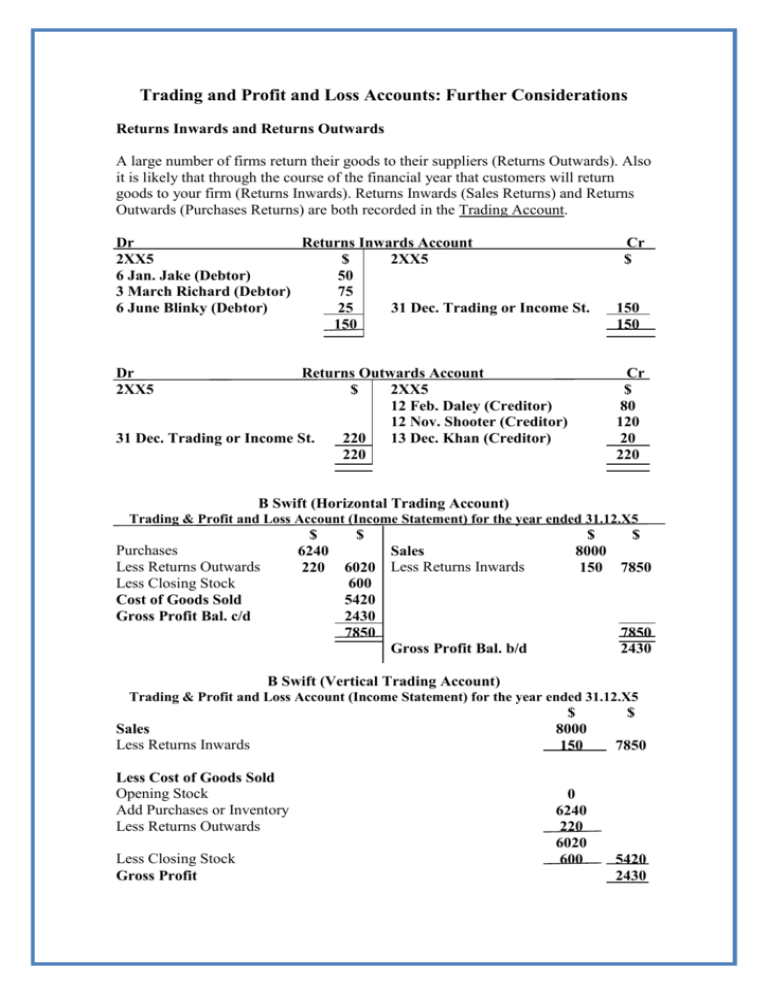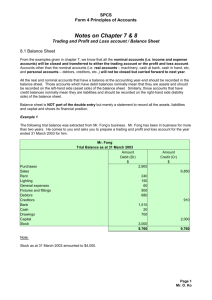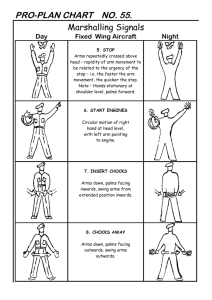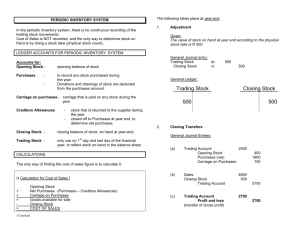Trading and Profit and Loss Accounts: Further
advertisement

Trading and Profit and Loss Accounts: Further Considerations Returns Inwards and Returns Outwards A large number of firms return their goods to their suppliers (Returns Outwards). Also it is likely that through the course of the financial year that customers will return goods to your firm (Returns Inwards). Returns Inwards (Sales Returns) and Returns Outwards (Purchases Returns) are both recorded in the Trading Account. Dr Returns Inwards Account 2XX5 $ 2XX5 6 Jan. Jake (Debtor) 50 3 March Richard (Debtor) 75 6 June Blinky (Debtor) 25 31 Dec. Trading or Income St. 150 Dr 2XX5 Returns Outwards Account $ 2XX5 12 Feb. Daley (Creditor) 12 Nov. Shooter (Creditor) 31 Dec. Trading or Income St. 220 13 Dec. Khan (Creditor) 220 Cr $ 150 150 Cr $ 80 120 20 220 B Swift (Horizontal Trading Account) Trading & Profit and Loss Account (Income Statement) for the year ended 31.12.X5 $ 6240 220 Purchases Less Returns Outwards Less Closing Stock Cost of Goods Sold Gross Profit Bal. c/d $ Sales 6020 Less Returns Inwards 600 5420 2430 7850 Gross Profit Bal. b/d $ $ 8000 150 7850 7850 2430 B Swift (Vertical Trading Account) Trading & Profit and Loss Account (Income Statement) for the year ended 31.12.X5 Sales Less Returns Inwards Less Cost of Goods Sold Opening Stock Add Purchases or Inventory Less Returns Outwards Less Closing Stock Gross Profit $ 8000 150 0 6240 220 6020 600 $ 7850 5420 2430 Carriages Inwards and Outwards The cost of the transport of goods (stock) into a firm is called Carriage Inwards (Purchases Carriages). The cost of delivering goods from the firm to the customer is known as Carriage Outwards (Sales Carriages). If a supplier charges you for the delivery of the goods on top of the cost of the purchases then accountants add this to the cost of sales. Therefore the cost of carriage inwards is recorded in the Trading Account. If you pay to deliver the goods to a customer then this cost is charged as an expense in the Profit and Loss Account of the firm. In both cases they are debit entries because they reduce the amount of sales located on the credit side of the trading and profit & loss account. Example Dr 19X5 31 Dec. Dr 19X5 31 Dec. Carriage Inwards Account $ 19X5 200 31 Dec. Trading or Income St. Jeffs Carriage Outwards Account $ 19X5 300 31 Dec. Profit & Loss or Income St. Prince Cr $ 200 Cr $ 300 B Swift (Horizontal Trading Account) Trading & Profit and Loss Account (Income Statement) for the year ended 31.12.X5 Purchases Less Returns Outwards Add Carriage Inwards Less Closing Stock Cost of Goods Sold Gross Profit Bal. c/d Less Expenses Electricity Wages Carriage Outwards Rent Net Profit Bal. c/d $ 6240 220 200 100 1000 300 400 $ Sales Less Returns Inwards $ $ 8000 150 7850 Gross Profit Bal. b/d 7850 2230 Net Profit Bal. b/d 2230 430 6220 600 5620 2230 7850 1800 430 2230 The Vertical Trading and Profit and Loss Account Format The vertical format is laid out in such a way so as to be more user-friendly for non accountants: B Swift Trading & Profit and Loss Account (Income Statement) for the year ended 31.12.X5 Sales Less Returns Inwards Less Cost of Goods Sold Opening Stock Add Purchases or Inventory Less Returns Outwards Add Carriage Inwards Less Closing Stock Gross Profit Less Expenses Rent Electricity Wages Carriage Outwards Net Profit $ 8000 150 0 6240 220 200 6220 600 400 100 1000 300 $ 7850 5620 2230 1800 430 Further Considerations: 1. 2. 3. a) b) 4. c) d) 5. 6. Sales Turnover = Sales – Sales Returns (Returns Inwards) Net Purchases = Purchases – Purchases Returns (Returns Outwards) How is gross profit affected if opening inventory (stock) is incorrect? Overvalued Gross Profit decreases Undervalued Gross Profit increase How is gross profit affected if closing inventory (stock) is incorrect? Overvalued Gross Profit increases Undervalued Gross Profit decreases Overvalued = overstated = overcast = overestimated = inflated Undervalued = understated = undercast = underestimated = deflated







